I²C vs SPI
Today, at the low end of the communication protocols, we find I²C (for
‘Inter-Integrated Circuit’, protocol) and SPI (for ‘Serial Peripheral
Interface’). Both protocols are well-suited for communications between
integrated circuits, for slow communication with on-board peripherals.
At the roots of these two popular protocols we find two major companies
– Philips for I²C and Motorola for SPI – and two different histories
about why, when and how the protocols were created.
The I²C bus was developed in 1982; its original purpose was to provide
an easy way to connect a CPU to peripherals chips in a TV set. Peripheral
devices in embedded systems are often connected to the microcontroller
as memory-mapped I/O devices. One common way to do this is connecting the
peripherals to the microcontroller parallel address and data busses. This
results in lots of wiring on the PCB (printed circuit board) and additional
‘glue logic’ to decode the address bus on which all the peripherals are
connected. In order to spare microcontroller pins, additional logic and
make the PCBs simpler – in order words, to lower the costs – Philips
labs in Eindhoven (The Netherlands) invented the ‘Inter-Integrated
Circuit’, IIC or I²C protocol that only requires 2 wires for connecting
all the peripheral to a microcontroller. The original specification
defined a bus speed of 100 kbps (kilo bits per second). The specification
was reviewed several times, notably introducing the 400 kbps speed in 1995
and – since 1998, 3.4 Mbps for even faster peripherals.
It seems the Serial Peripheral Protocol (SPI) was first introduced with
the first microcontroller deriving from the same architecture as the
popular Motorola 68000 microprocessor, announced in 1979. SPI defined the
external microcontroller bus, used to connect the microcontroller
peripherals with 4 wires. Unlike I²C, it is hard to find a formal separate
‘specification’ of the SPI bus – for a detailed ‘official’
description, one has to read the microcontrollers data sheets and
associated application notes.
SPI
SPI is quite straightforward – it defines features any digital electronic
engineer would think of if it were to quickly define a way to communicate
between 2 digital devices. SPI is a protocol on 4 signal lines (please
refer to figure 1):
– A clock signal named SCLK, sent from the bus master to all slaves; all
the SPI signals are synchronous to this clock signal;
– A slave select signal for each slave, SSn, used to select the slave
�
the master communicates with;
– A data line from the master to the slaves, named MOSI (Master Out-Slave
In)
– A data line from the slaves to the master, named MISO (Master In-Slave
Out).
SPI is a single-master communication protocol. This means that one central
device initiates all the communications with the slaves. When the SPI
master wishes to send data to a slave and/or request information from it,
it selects slave by pulling the corresponding SS line low and it activates
the clock signal at a clock frequency usable by the master and the slave.
The master generates information onto MOSI line while it samples the MISO
line (refer to figure 2).
�
Four communication modes are available (MODE 0, 1, 2, 3) – that basically
define the SCLK edge on which the MOSI line toggles, the SCLK edge on which
the master samples the MISO line and the SCLK signal steady level (that
is the clock level, high or low, when the clock is not active). Each mode
is formally defined with a pair of parameters called ‘clock polarity’
(CPOL) and ‘clock phase’ (CPHA).
�
A master/slave pair must use the same set of parameters – SCLK frequency,
CPOL, and CPHA for a communication to be possible. If multiple slaves are
used, that are fixed in different configurations, the master will have
to reconfigure itself each time it needs to communicate with a different
slave.
This is basically all what is defined for the SPI protocol. SPI does not
define any maximum data rate, not any particular addressing scheme; it
does not have a acknowledgement mechanism to confirm receipt of data and
does not offer any flow control. Actually, the SPI master has no knowledge
of whether a slave exists, unless ‘something’ additional is done outside
the SPI protocol. For example a simple codec won’t need more than SPI,
while a command-response type of control would need a higher-level
protocol built on top of the SPI interface. SPI does not care about the
physical interface characteristics like the I/O voltages and standard
used between the devices. Initially, most SPI implementation used a
non-continuous clock and byte-by-byte scheme. But many variants of the
protocol now exist, that use a continuous clock signal and an arbitrary
transfer length.
Back to Top
I²C
�
I²C is a multi-master protocol that uses 2 signal lines. The two I²C
signals are called ‘serial data’ (SDA) and ‘serial clock’ (SCL). There
is no need of chip select (slave select) or arbitration logic. Virtually
any number of slaves and any number of masters can be connected onto these
2 signal lines and communicate between each other using a protocol that
defines:
– 7-bits slave addresses: each device connected to the bus has got such
a unique address;
– data divided into 8-bit bytes
– a few control bits for controlling the communication start, end,
direction and for an acknowledgment mechanism.
The data rate has to be chosen between 100 kbps, 400 kbps and 3.4 Mbps,
respectively called standard mode, fast mode and high speed mode. Some
I²C variants include 10 kbps (low speed mode) and 1 Mbps (fast mode +)
as valid speeds.
Physically, the I²C bus consists of the 2 active wires SDA and SCL and
a ground connection (refer to figure 4). The active wires are both
bi-directional. The I2C protocol specification states that the IC that
initiates a data transfer on the bus is considered the Bus Master.
Consequently, at that time, all the other ICs are regarded to be Bus
Slaves.
�
First, the master will issue a START condition. This acts as an ‘Attention’
signal to all of the connected devices. All ICs on the bus will listen
to the bus for incoming data.
Then the master sends the ADDRESS of the device it wants to access, along
with an indication whether the access is a Read or Write operation (Write
in our example). Having received the address, all IC’s will compare it
with their own address. If it doesn’t match, they simply wait until the
bus is released by the stop condition (see below). If the address matches,
however, the chip will produce a response called the ACKNOWLEDGE signal.
Once the master receives the acknowledge, it can start transmitting or
receiving DATA. In our case, the master will transmit data. When all is
done, the master will issue the STOP condition. This is a signal that
states the bus has been released and that the connected ICs may expect
another transmission to start any moment.
When a master wants to receive data from a slave, it proceeds the same
way, but sets the RD/nWR bit at a logical one. Once the slave has
acknowledged the address, it starts sending the requested data, byte by
byte. After each data byte, it is up to the master to acknowledge the
received data (refer to figure 5).
�
START and STOP are unique conditions on the bus that are closely dependent
of the I²C bus physical structure. Moreover, the I²C specification states
that data may only change on the SDA line if the SCL clock signal is at
low level; conversely, the data on the SDA line is considered as stable
when SCL is in high state (refer to figure 6 hereafter).
�
At the physical layer, both SCL and SDA lines are open-drain I/Os with
pull-up resistors (refer to figure 4). Pulling such a line to ground is
decoded as a logical zero, while releasing the line and letting it flow
is a logical one. Actually, a device on a I²C bus ‘only drives zeros’.
Here we come to where I²C is truly elegant. Associating the physical layer
and the protocol described above allow flawless communication between any
number of devices, on just 2 physical wires.
For example, what happens if 2 devices are simultaneously trying to put
information on the SDA and / or SCL lines?
At electrical level, there is actually no conflict at all if multiple
devices try to put any logic level on the I²C bus lines simultaneously.
If one of the drivers tries to write a logical zero and the other a logical
one, then the open-drain and pull-up structure ensures that there will
be no shortcut and the bus will actually see a logical zero transiting
on the bus. In other words, in any conflict, a logic zero always ‘wins’.
The bus physical implementation also allows the master devices to
simultaneously write and listen to the bus lines. This way, any device
is able to detect collisions. In case of a conflict between two masters
(one of them trying to write a zero and the other one a one), the master
that gains the arbitration on the bus will even not be aware there has
been a conflict: only the master that looses will know – since it intends
to write a logic one and reads a logic zero. As a result, a master that
looses arbitration on a I²C will stop trying to access the bus. In most
cases, it will just delay its access and try the same access later.
Moreover, the I²C protocol also helps at dealing with communication
problems. Any device present on the I²C listens to it permanently.
Potential masters on the I²C detecting a START condition will wait until
a STOP is detected to attempt a new bus access. Slaves on the I²C bus will
decode the device address that follows the START condition and check if
it matches theirs. All the slaves that are not addressed will wait until
a STOP condition is issued before listening again to the bus. Similarly,
since the I²C protocol foresees active-low acknowledge bit after each byte,
the master / slave couple is able to detect their counterpart presence.
Ultimately, if anything else goes wrong, this would mean that the device
‘talking on the bus’ (master or slave) would know it by simply comparing
what it sends with what is seen on the bus. If a difference is detected,
a STOP condition must be issued, which releases the bus.
�
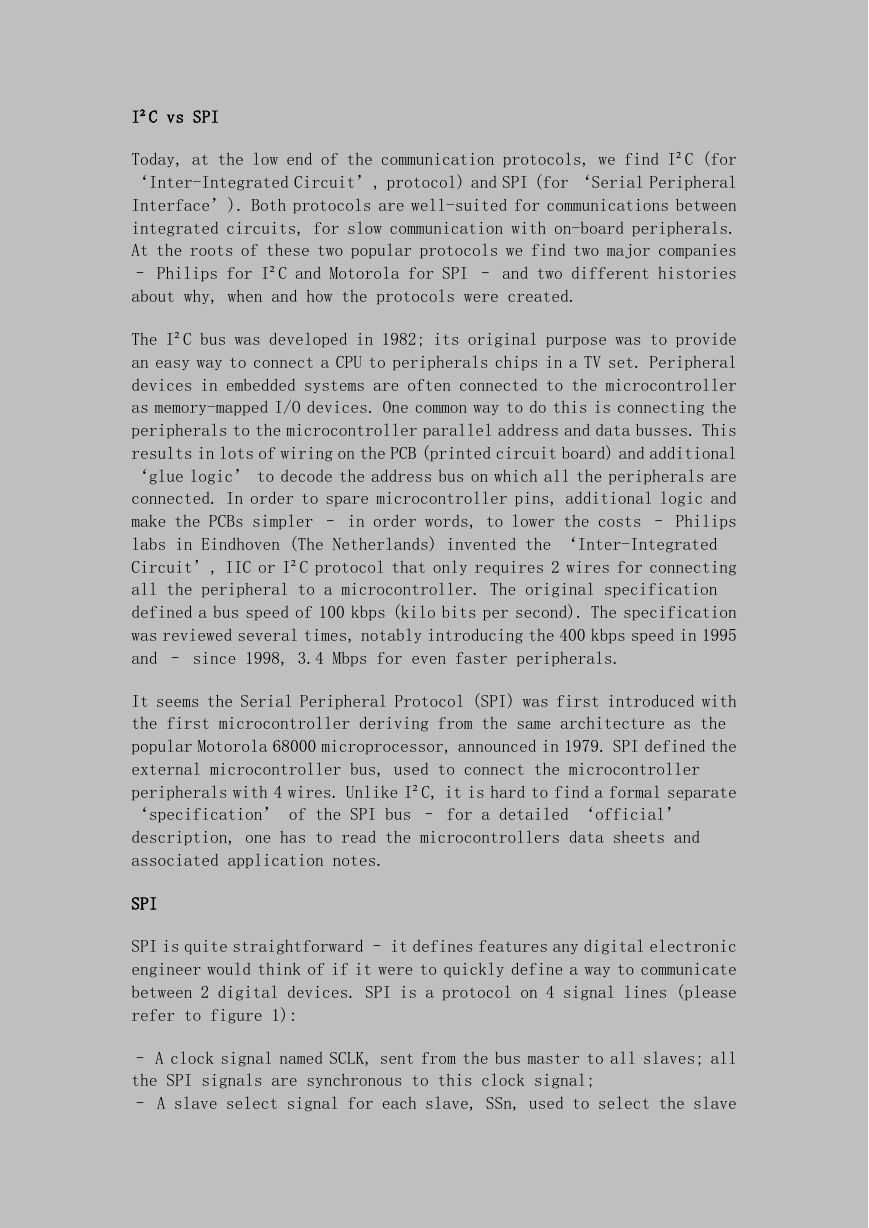
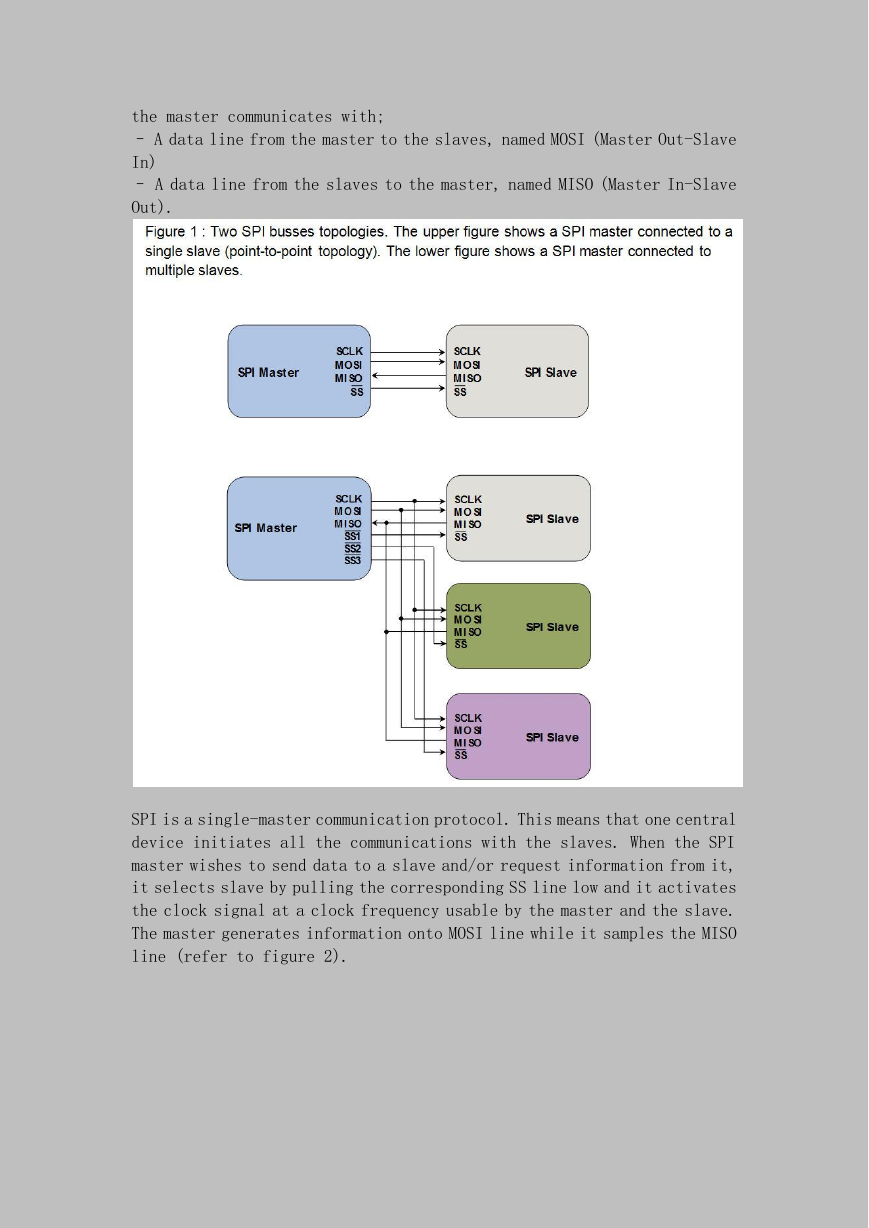

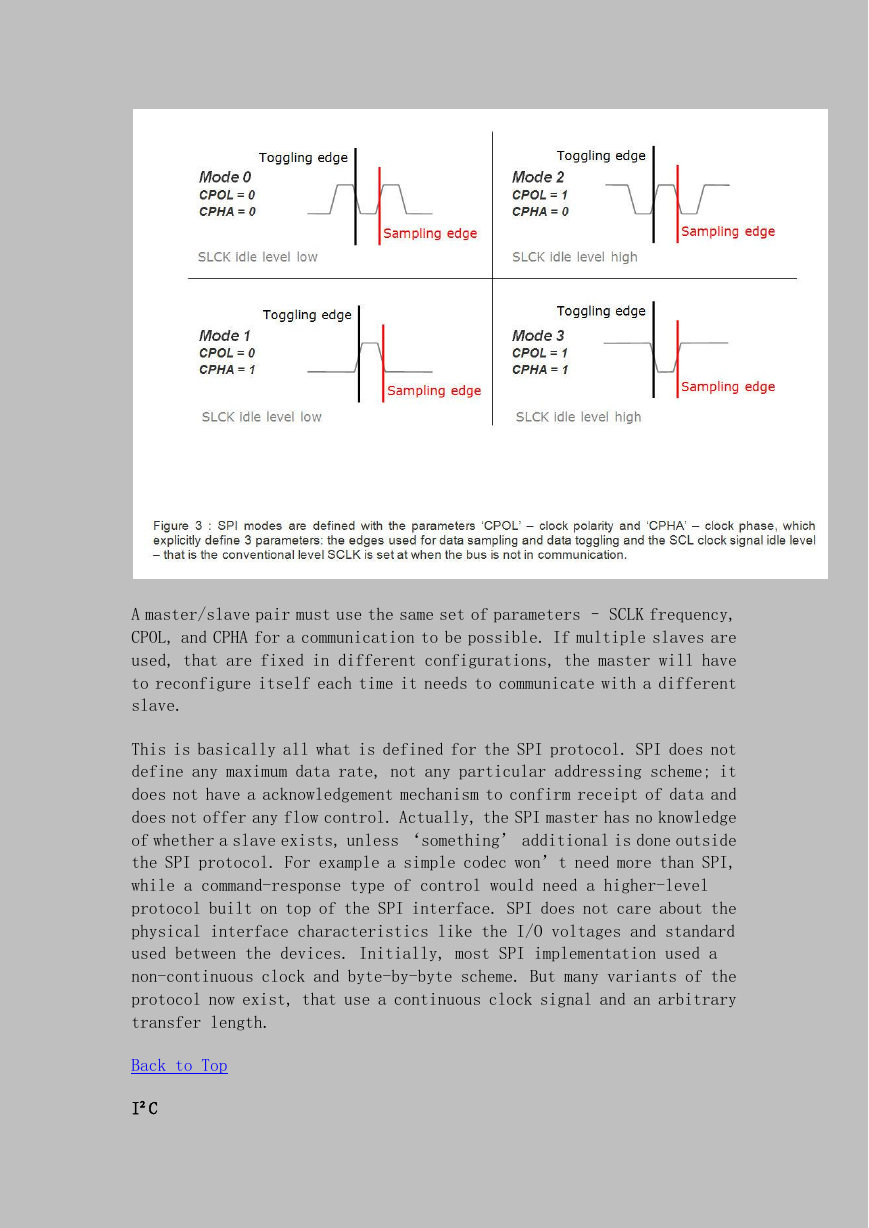

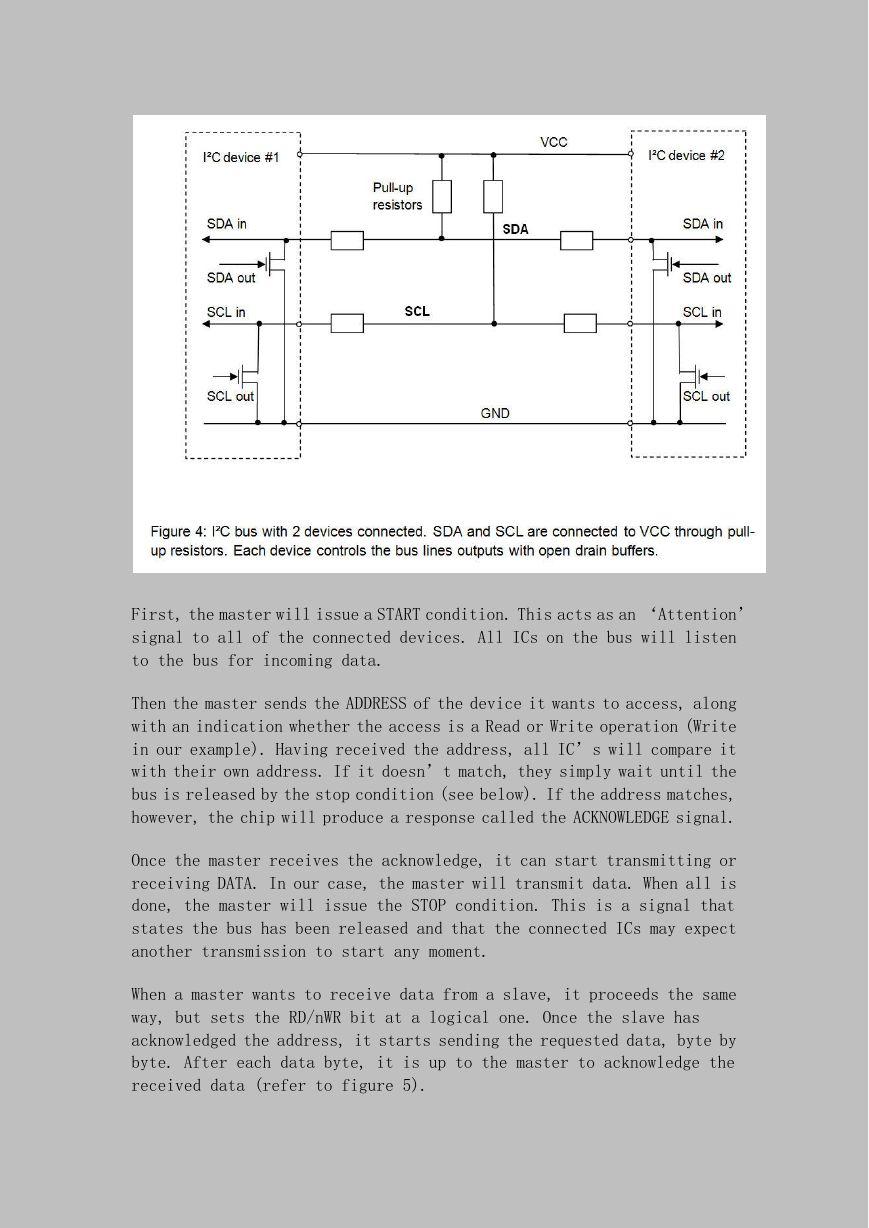
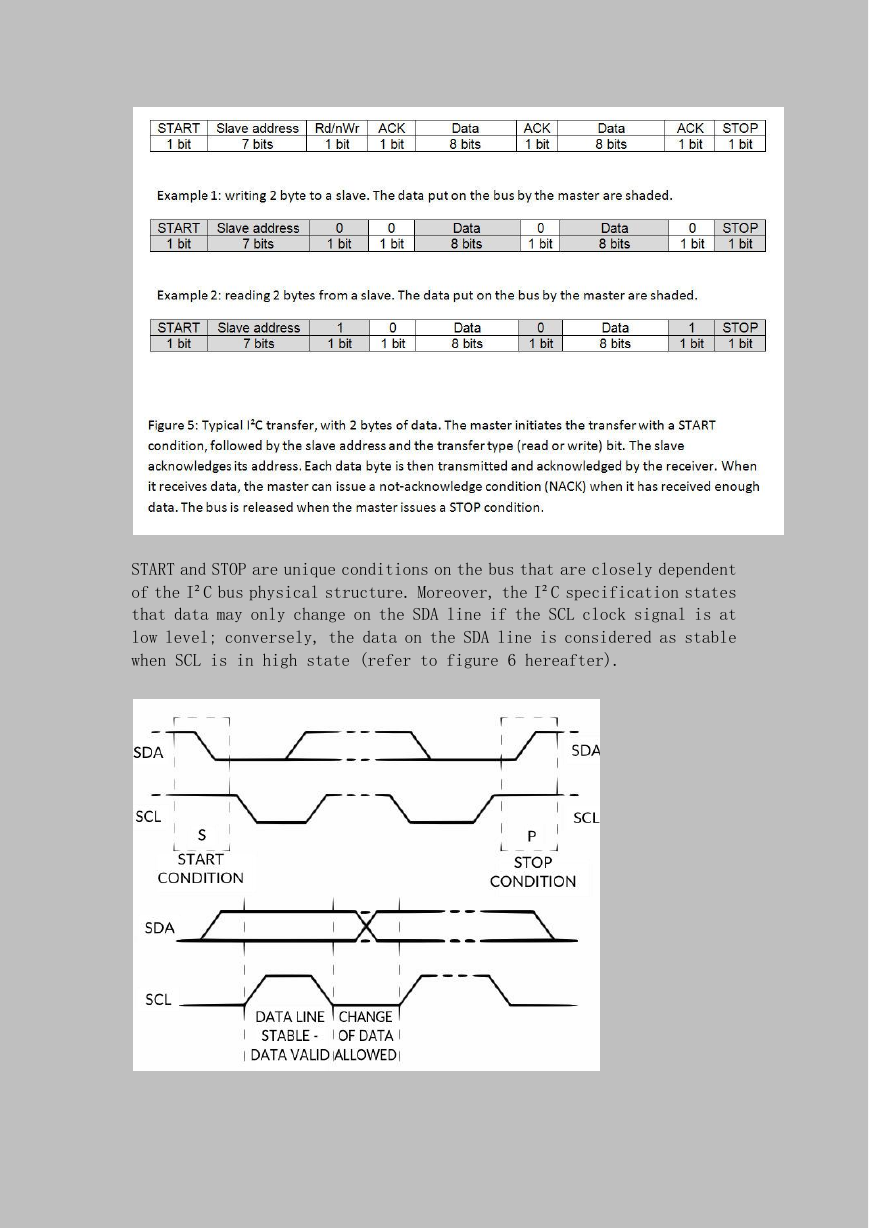
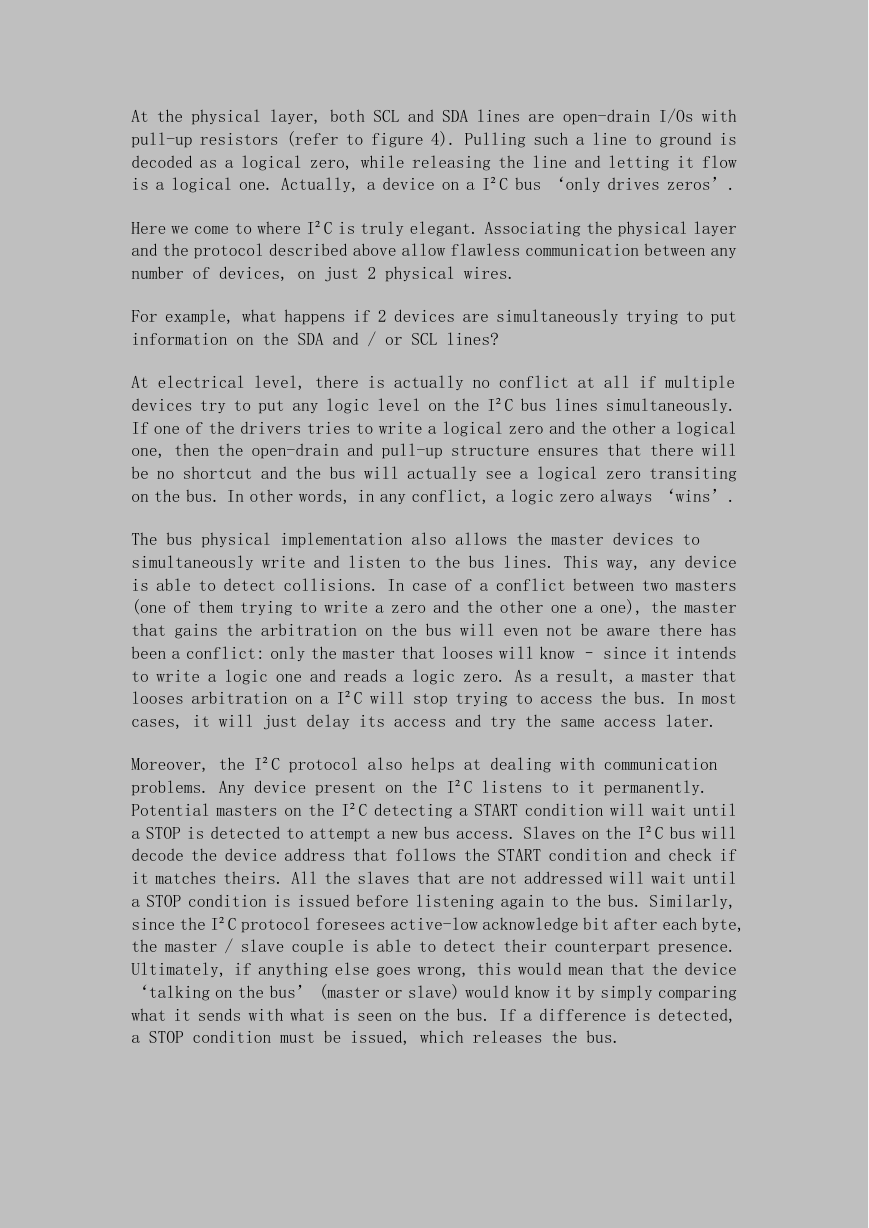








 2023年江西萍乡中考道德与法治真题及答案.doc
2023年江西萍乡中考道德与法治真题及答案.doc 2012年重庆南川中考生物真题及答案.doc
2012年重庆南川中考生物真题及答案.doc 2013年江西师范大学地理学综合及文艺理论基础考研真题.doc
2013年江西师范大学地理学综合及文艺理论基础考研真题.doc 2020年四川甘孜小升初语文真题及答案I卷.doc
2020年四川甘孜小升初语文真题及答案I卷.doc 2020年注册岩土工程师专业基础考试真题及答案.doc
2020年注册岩土工程师专业基础考试真题及答案.doc 2023-2024学年福建省厦门市九年级上学期数学月考试题及答案.doc
2023-2024学年福建省厦门市九年级上学期数学月考试题及答案.doc 2021-2022学年辽宁省沈阳市大东区九年级上学期语文期末试题及答案.doc
2021-2022学年辽宁省沈阳市大东区九年级上学期语文期末试题及答案.doc 2022-2023学年北京东城区初三第一学期物理期末试卷及答案.doc
2022-2023学年北京东城区初三第一学期物理期末试卷及答案.doc 2018上半年江西教师资格初中地理学科知识与教学能力真题及答案.doc
2018上半年江西教师资格初中地理学科知识与教学能力真题及答案.doc 2012年河北国家公务员申论考试真题及答案-省级.doc
2012年河北国家公务员申论考试真题及答案-省级.doc 2020-2021学年江苏省扬州市江都区邵樊片九年级上学期数学第一次质量检测试题及答案.doc
2020-2021学年江苏省扬州市江都区邵樊片九年级上学期数学第一次质量检测试题及答案.doc 2022下半年黑龙江教师资格证中学综合素质真题及答案.doc
2022下半年黑龙江教师资格证中学综合素质真题及答案.doc